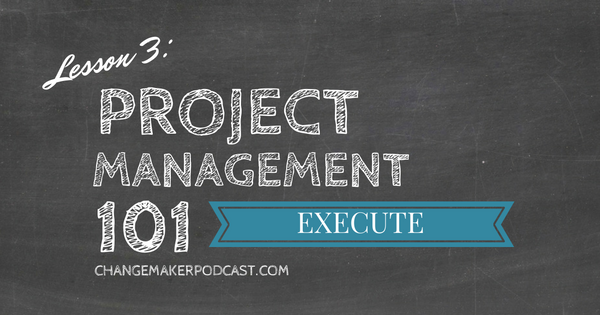Get more good stuff.

In our last lesson, we determined our project plan. For today’s post we’ll focus on item #3, Execute, where the work gets done!
This is the third of the 5-post series on how to manage a project. The 5 key steps to managing a project are:
- Idea Approval – What do you want to do? Why?
- Plan – How are you going to do it?
- Execute – Let’s get it done!
- Check and Control – Keep the project on track.
- Close – Wrap up the project.
Execute – Let’s get it done!
In this phase, we build the actual product, service, or result required for the project. We’ll focus on three areas to do this:
- Team – Help your team to be successful.
- Managing Work – Collect status updates and manage change requests.
- Communication – This is 80% of what you’ll be doing in this phase.
Team
Key Principles to Team Building
It’s the job of the project manager to set the team up for success. You’ve built a solid foundation with the project plan, but the team is depending on you to guide them, encourage collaboration, remove barriers, and provide protection.
1. Trust
Trust is a core principle in managing a team effectively.
- Demonstrate trust by being on-time, consistent, available, and accountable.
- Get to know people personally and understand that they have a life outside of work.
- Listen before talking.
- Rely on your team for their knowledge and skills. Ask them for their input and advice.
- Be transparent. Share what you can as soon as you can.
- Shield your team from politics and drama by being the first point of contact for the project.
2. Vision
Lead your team to achieve a common goal by creating a vision.
- Use the project plan to help the team understand “why” you’re doing the project and “what” you need to do to get there.
- Help people to shift from “doing their job” to “making an impact.” Ensure they know they are needed to solve important and challenging problems.
3. Recognition 
Recognize the team’s effort to help keep the project on track and deliver a great result.
- Celebrate successes as a team when key milestones are reached or just because.
- Say “thank you” to your team for their contributions.
- Applaud new and creative ideas, even if they fail.
4. Accountability
You may have heard the phrase “a team is only as good as its weakest player.” By holding both the team and individuals accountable, you create a stronger team.
- Create an environment where it is encouraged to ask for help and to provide help.
- Ensure the team respects each other, even when there are disagreements.
- Take action if someone’s attitude is pulling down the team – do not ignore the behavior as it will negatively impact the team.
Managing Work
The project plan is the road map for the execution of the project. Of course, not everything goes exactly to plan and that’s where project management is needed.
First, ensure that each member of your team has the tools and training they need to get the job done.
The project schedule should be made easily available so everyone is aware of their tasks and when they need to complete them. As you get confirmation of completed tasks, update the schedule and budget accordingly.
Status Updates
Status updates can be obtained through team meetings and checking-in with team members.
Team Meetings
When used effectively, team meetings encourage collaboration, provide project clarity, remove barriers, and ensure accountability.
In the beginning of the project, more frequent team meetings are beneficial as everything is new. I recommend starting these weekly and then reducing the frequency to bi-weekly as the project moves along. Meetings should always serve a purpose and have an agenda, such as the following:
- Status Updates – each team member gives an update on their status.
- By sharing updates as a team, accomplishments can be celebrated. Additionally, team members feel more accountability if they fall behind schedule. They see the impact this has on the team, so there is more pressure to get back on track.
- Overall Progress – show where the project is at from a whole
- As each person is focused on separate pieces of the project, it’s nice to see the big picture and how everything fits together.
- Discuss next steps and who will be involved with that work.
- Update Issues and Risks
- By discussing issues and risks in a supportive environment, the team can work to resolve problems together.
- Ensure that each issue and risk has an action item for resolution and an owner.
- Encouragement – encourage the team and thank them for their work
- Without the project team, there wouldn’t be a project. Recognize your team’s efforts, cheer them on through their upcoming challenges, and thank them for their contributions.
Checking-In
Check in with each team member a couple of times a week to listen. Instead of asking “what’s the status of your task?” ask each person “how are you doing?” They may answer with how their weekend was or a movie they saw. They may say that their work is going well or share a problem that they’re stuck on.
Regardless of what they say, this is not a waste of time. It’s about building trust with your team and letting them know that you’re there when they need you.
Schedule and Budget Updates
Using the status updates from the team, update the schedule and budget accordingly.
The budget updates will come from actual expenses and actual hours that have been reported for the project. The additional money and time tied to specific risks in the form of contingency should also be updated.
Items for the schedule should be marked as completed and in-progress so anyone knows the status of the project at any given time.
Critical Path
When managing your project, it is important to be aware of the critical path, or the longest path of dependent activities in your project schedule. The critical path is shown in red below.
Example:

A path is critical because any delays will push the delivery date of the entire project. If a task in red takes a day longer, the whole project will be delayed by one day.
However, there is some flexibility with non-critical path tasks. For example, task 11 above (Photos) has about a week of time before it will be on the critical path – when task 13 (Test Website Per Requirements) is scheduled to start.
Regardless of a task being on the critical path or not, it is best to have an action plan to get back on track with the project schedule.
Change Requests
Throughout the course of the project, changes will be requested.
Remember the Project Management Triangle when faced with changes to the project requirements. Some changes can be made without much effort and without delay to the schedule or increase in costs. Others will impact the project delivery date, budget, scope, or quality.
Change Review Board
For those change requests that will impact the project outcome, ask the requestor to prepare rationale supporting the change and present the request to a Change Review Board. The board, made up of the project sponsor and other key stakeholders, will then approve or reject the change.
By having this process in place, the requestor is more likely to bring up meaningful changes versus less significant ones (e.g “can you change all of the purple to a fuchsia tone?”).
Communication
Most time as a project manager is spent communicating. In the Execute phase, I estimate communication to take up 80% of a project manager’s time.
We learned above that there is communication involved with building a strong team, collecting status updates, and managing changes.
In addition to these communications, it’s important to share information with stakeholders regularly so they are informed with the status of the project.
I recommend bi-weekly emails with the following information:
- What happened since the last communication.
- What is planned until the next communication.
- What the overall delivery date is.
- List of important issues and risks that stakeholders should be made aware of.
That sums up the Execute phase. This phase is usually the longest and I also find it to be the most fun as the team is working together to create something great!
 Important Tips
Important Tips
I’ve made a lot of mistakes while managing projects and I want to help you avoid making the same ones. Here are some additional tips that will save you major headaches:
Trust and a New Team Member
Trust is essential, but takes time to earn.
When working with new team members, there is no prior knowledge of how they work and communicate. This can make project management difficult. Someone may be more optimistic and say that a task can get done in a week, but it could end up taking a month. To help with this risk, I ask for status updates more frequently until trust is earned.
If a task is about 80 hours, check 20 hours in that the task is a quarter of the way done. Then check 40 hours in that the task is half way complete and again at 80 hours that the task is done.
When the results are reliable and as planned, you should step back and let your team member communicate with you during regularly planned status updates.
If deliverables continue to be delayed, work together with the team member to determine the reason for that and do what you can to get things back on track.
Vendors Need to Be Managed
A while back I created a mobile app and worked with a vendor to do it. In our initial discussions on roles and responsibilities, the vendor mentioned that they were responsible for managing the development and graphic design work of the project.
“Hooray! This will be great!” I thought. “I’ll just keep doing other things while they do all the work and I’ll wait for the email telling me the app is ready for testing – so easy!”
Not so fast. I never got the email I was expecting. When I reached out to the vendor, I realized that his developers were stuck and hadn’t even gotten half way done, the graphic designer was caught up with another project, and my app would maybe be completed in a couple of months.
I learned that vendors need to be managed too. Even if they have a project manager on their team, there need to be regular communications, milestones, and expectations set for the project.
